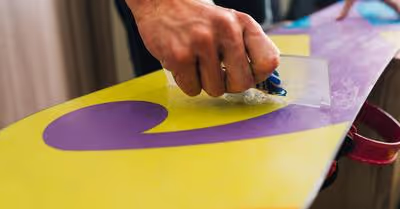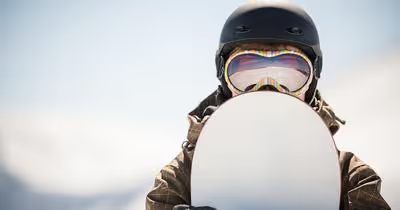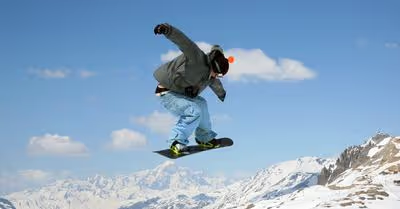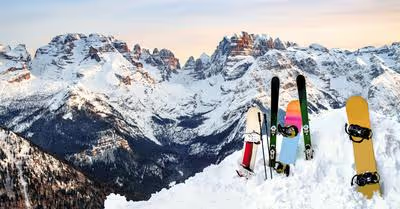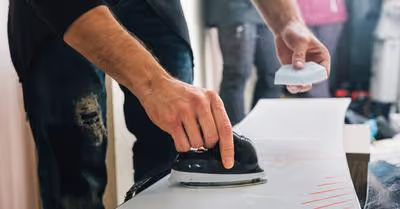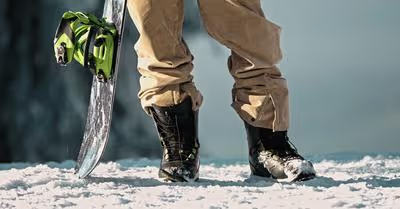Table of Contents
What’s the Difference Between Freestyle and Freeride Snowboarding?
Every snowboarder is unique, and almost no one fits neatly into one of these two categories. They’re both approaches to riding, and you might choose a more freestyle or freeride technique on any given trail, mountain, day, or season. But most riders lean one way or another.
For instance, I’d define myself as about 65% freerider. I enjoy freestyle and incorporate a lot of it into my riding, but I spend most of my time outside the terrain park.
What is Freeride Snowboarding?
Freeriding is just snowboarding with no agenda. If you’re not doing tricks, racing, or following a prescribed course, you’re probably freeriding. When you take the lift up, pick a trail, and then cruise down at your own pace, turning when you want to turn, that’s freeriding.
You can freeride on Green, Blue, Black, and Double Black trails, and you can freeride in moguls, glades, and the backcountry.
In the world of professional and competitive snowboarding, freeride refers specifically to backcountry or off-piste riding to distinguish those kinds of competitions from more traditional freestyle and racing events.
What is Freestyle Snowboarding?
Freestyle snowboarding means that you’re performing some kind of a trick. This is most commonly done in terrain parks, which are built for freestyle riding.
Common freestyle features include:
- Jumps
- Boxes
- Rails
- Halfpipes
Common freestyle tricks include:
- Grabs (Nose Grab, Tail Grab, Method)
- Spins (180s, 360s, 540s)
- Flips (Backflip, Frontflip)
- Corked Spins (Combined spins and flips)
- Grinds (ways to hit rails and boxes — Front Lip, Board Slide)
While terrain parks are built for freestyle, freestyle can be done anywhere on the mountain. Hitting a cliff drop in the glades, finding a kicker on the side of the trail, or doing an Ollie or Tailpress while riding are all freestyle.
In the professional and competitive world, the primary freestyle events are halfpipe, slopestyle, and big air. Your local mountain likely also hosts a rail jam.
What Kind of Snowboard Should I Get?
So now that you have a better sense of some of the different styles of snowboarding, you can shop confidently for your next board — maybe even look for some deals online — instead of having to blindly trust an expert.
Freeride and Freestyle snowboards are two ends of a spectrum. Freeride boards are directional and tough, built to hold up in the backcountry. Freestyle boards are flexible and playful to take your park-style anywhere. If you’re somewhere in between, All-mountain boards offer a compromise.
Snowboard Features
So what does it mean that a Freeride snowboard is directional? Let’s dive into the elements you’ll want to consider when choosing a board.
- Shape: snowboards can be directional, directional twin, or true twin. Everything about a true twin snowboard is balanced and centered for maximum flexibility to ride in either direction. Directional boards, on the other hand, place your feet towards the back of the board and tailor the whole shape of the board to move better in one direction. Directional twin boards compromise with a directional shape but centered feet to offer some comfort riding backward.
- Length: It’s generally recommended that your snowboard should be a little shorter than you; standing on end it should land between your chin and mouth. However, rider weight is also a consideration, as are the conditions you’ll mostly be riding.
- Width: Usually, you want your snowboard to be slightly narrower than your boots. But again, weight, riding style, and conditions should be considered.
- Profile: The traditional snowboard profile is camber. Cambered snowboards have a wavy profile with low points under both feet, an arc in the middle, and high points at the nose and tail. Rocker snowboards were introduced later. They’re shaped like a banana with a low point in the center and a consistent arc outwards. Since then, snowboard companies have come out with a wide variety of hybrid profiles that blend the two approaches.
- Stiffness/Flex: This is primarily measured end to end and is most visually obvious when riders are doing buttered tricks like tail presses.
How you think about and choose between all those features depends on what kind of riding you’re planning to do.
Freeride Snowboards
Freeride snowboards are built to hold up in the backcountry or off-piste. They’re usually directional so that the rider has maximum control and responsiveness when riding regular (or forward). The shape of the board and the stance (set back) are usually geared towards powder. They’re usually fairly stiff as well to provide responsiveness, hold up in a variety of snow conditions, and handle landings from big backcountry airs and cliff drops.
Conditions off-piste can change on a dime; these boards are built to be bullet-proof. That doesn’t necessarily make them easy to ride, but generally, anyone riding in the backcountry should be an expert snowboarder.
Freestyle Snowboards
Freestyle snowboards are almost the complete opposite of freeride snowboards. They’re usually true twin to accommodate freestyle riders regularly spinning and riding switch (backward). They’re also usually light, short, and flexible, which makes jumping, buttering, and spinning easier.
While built for the terrain park, many riders prefer freestyle boards for riding anywhere on the mountain. If you’re not racing and enjoy playing around, a freestyle board might be right for you. They don’t offer as much stability riding fast on groomed terrain, and they require a little more effort when riding in powder because of their flexibility.
All-mountain Snowboards
All-mountain boards are the happy medium and probably the most popular style on the market. They’re built to handle a variety of conditions better than freestyle boards but they remain twin or directional twin and can hold up in the park.
All-mountain boards also come in a wide variety of styles, so if you love the stiffness of a freeride board, but you don’t want it to be directional, for example, you can probably find an all-mountain board that’s a good fit for you.
In addition to those three main categories, there are a few other kinds of snowboards you may encounter.
Powder Snowboards
Powder boards are built exclusively for cruising in deep, fresh powder. They’re usually short and wide with a stance set very far back to provide maximum float in deep snow. They share some features with freeride boards but don’t hold up well in the variety of conditions the backcountry offers.
For most snowboarders, a powder board is a second, luxury board to be brought out on the days the whole mountain is covered in fresh snow. But some riders take them everywhere. They’ve become a popular style statement because their size and shape are so unique and stand out.
Split Snowboards
Split snowboards are for getting places the lifts won’t take you. They split in half to form cross-country skis that, with skins attached, can be used to travel uphill. Then they reattach to let you snowboard down in fresh snow that no one else has touched.
These are also usually luxury second boards. Because of the extra hardware, they cost significantly more than, sometimes twice as much as, other snowboards, and because of the hardware and the split in the middle, they don’t ride as well on groomed terrain and aren’t at all appropriate for freestyle.
You’ll want to be sure you’re ready to commit to using a splitboard regularly before buying one.
Beginner Snowboards
What if you don’t know what kind of a snowboarder you are because you’re just learning? The three most important elements in a beginner snowboard are shape, profile, and flex. You’ll want a twin board because you won’t know if you ride regular or switch yet; a flexible board that will respond easily to your movements; and a board with more rocker than camber in its profile that will make it harder for you to accidentally dig in an edge and fall.
Many freestyle and all-mountain boards work well to learn on. However, many snowboard companies make boards specifically for the learning process. Consider visiting your local rental shop for your first few times out. This will allow you to learn on a board built just for that and start to build a sense of the kind of rider you are before you purchase the perfect board.
Recent Articles



